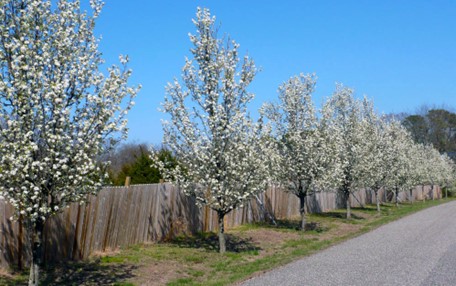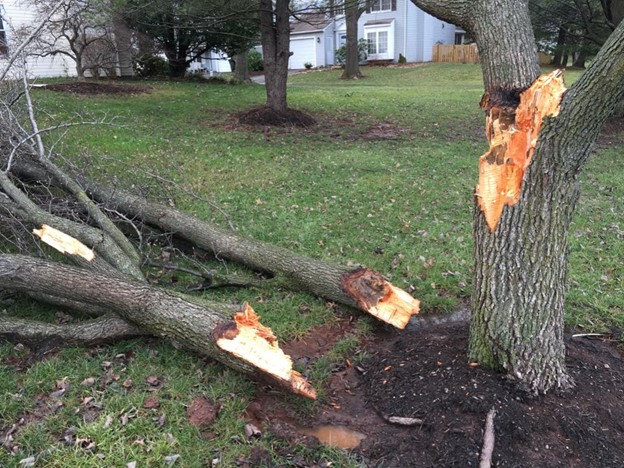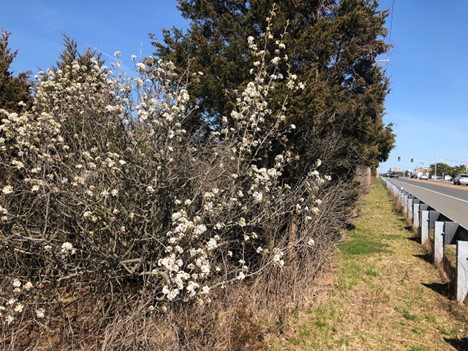
PAT SUTTON/Bradford pear trees.
By STEVE JASIECKI
Spring is here and trees and flowers are beginning to bloom. Driving around town in April you can’t help but notice the abundance of white flowering trees that are just about everywhere. And boy do they reek! These trees are the highly invasive Bradford pear, Pyrus calleryana (also known as Callery pear, Cleveland pear etc.)
The Pyrus calleryana was brought to the United State from China in the early 1900s.
Agricultural researchers noted that the Callery thrived in a variety of climates and soils, grew fast and was resistant to diseases.
During the 1950s, agriculturalists started cultivating the tree into various species. The first cultivator was named after horticulturist F.C. Bradford, hence the name Bradford pear. Its rapid growth, flowering petals and enduring foliage made this the ideal landscape tree, or so everyone thought, and was commercially released in 1961.
Their hardiness and ability to grow in a variety of locations with minimum care made them very popular with developers, city architects and landscapers. Pyrus calleryana trees were planted as street trees, in parking lots, business districts, city parks, virtually everywhere. And without a mixture of other trees, a monoculture of Callery pears sprang up making them the predominant city tree in many communities.
PROBLEMS
Eventually, as the trees matured, their downsides started to emerge. Callery pear branches are weak and would snap during windstorms and under heavy snow. When they bloomed in the spring, they release a pungent odor reminiscent of rotting fish.
Because they didn’t evolve in this country, the trees are not compatible with the local wildlife. Entomologists noticed they did not attract the beneficial insects that wildlife, particularly birds, feed upon.

Callery pear branches are weak and can break off during storms
Aside from that, the trees are highly invasive. The trees were cultivated to be sterile, but the process failed. Seeds of the trees would disperse and new saplings would sprout up wherever they landed. Spreading like weeds, they compete for space with local trees, and are crowding them out.
This is obvious in the spring when their blooming white petals make them stand out amid other trees. Examples of this infiltration can be seen along the causeways where you will see white Callery pears growing among the red cedars.
A GROWING CONCERN
The states of Ohio, South Carolina and Pennsylvania, and various cities across the nation acted by banning the selling and planting of these trees.
The New Jersey Invasive Species Strike Team recognizes that it is a problem tree and has placed it on the Do Not Plant list. However, it is not yet banned in New Jersey and still available for purchase.
The Callery/Bradford pear is just one of many trees on the New Jersey Strike Team’s tree plant list, and unfortunately, it is still being planted by landscapers and contractors to satisfy building landscape requirements.

JASIECKI/An invasive Bradford Pear takes root on the Longport causeway.
It is highly recommended that everyone stop planting this invasive, foul smelling tree, and when practical, replace them with a more appropriate, native trees.
For more information and a selection of appropriate trees to plant, visit Pat Sutton’s Wildlife garden at http://www.patsuttonwildlifegarden.com/pat-sutton/
Also see the Jersey Friendly Yards site at https://www.jerseyyards.org/plant/?fwp_text_search=trees.
For a full accounting of the New Jersey Strike Team list, visit https://www.princetonnj.gov/DocumentCenter/View/1710/2020-Do-Not-Plant-List-PDF


